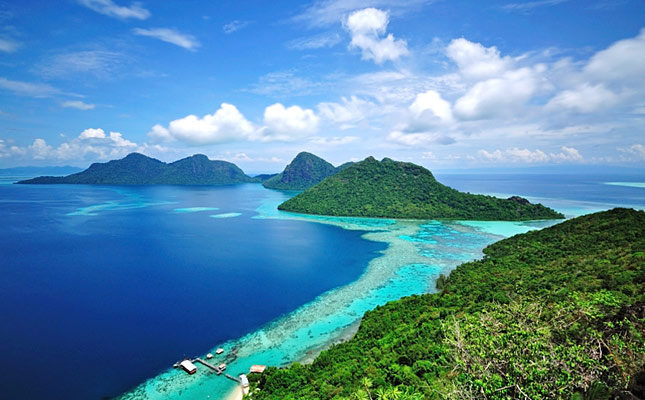[fshow photosetid=72157646133723040]
At some 140 million years, Borneo’s dense rainforests is one of the oldest in the world and the island is home to no less than some 15,000 species of flowing plants, 3,000 species of trees, 220 species of terrestrial mammals and 420 species of birds.
It is one of the most ecologically diverse places in the world and also the natural habitat for some of the most endangered species, including the Asian elephant, the Sumatran rhinoceros, the Bornean clouded leopard and the Bornean orangutan, to name but a few.
As a result of this diversity and natural beauty, the island, and especially the Malaysian states of Sarawak and Sabah in the north, have become popular travel destinations for those in search of extraordinary outdoor experiences.
Orangutan Experience
Few travellers visit Borneo without stopping at a wildlife reserve in the hope they might see a wild orangutan. There are only two places in the world where these fascinating animals still live in the wild, Sumatra being the other one.
While the rainforest used to have a much larger number of orangutans; heavy, and oftentimes illegal, logging and the creation of palm tree plantations in both the Malaysian and Indonesian parts of Borneo means large parts of their natural habitat have disappeared, and today there are only a few truly wild orangutans left on Borneo.
There are two main wildlife centres where visitors get a chance to see semi-wild orangutans during feedings times. The Sepilok Orangutan Rehabilitation Centre is located in Sabah state within the Kabili Sepilok Forest Reserve. The centre is protected and supported by the Forest Department and is home to some 60 to 80 orangutans in addition to around 25 young orphaned orangutans that are kept in the nurseries and will be released when they are old enough to take care of themselves.
The other large sanctuary is Semenggoh Wildlife Rehabilitation Centre in Sarawak state. It was established almost 35 years ago as a centre for injured and orphaned orangutans and has since developed into a rehabilitation centre and a place to educate visitors about the species. There are currently 26 orangutans roaming free in the Centre’s 740 hectare forest reserve.
Climbing Kinabalu
Another of the most popular tourist attractions and outdoor experiences in Malaysian Borneo is a climb to the summit of Mount Kinabalu. Rising 4,095 metres above sea level, the mountain is situated in Sabah within the Kinabalu Park, a UNESCO World Heritage Site.
Climbing Mount Kinabalu will take you through various terrains from lowland rainforest to montane forest, cloud forest, sub-alpine meadow and finally bare granite at the summit. Depending on the season, on the way up you will also see various types of flora including conifers, climbing bamboo, superb agathis and, as you reach further up, moss and liverworts.
If you visit during the summer period, as we did, you will see plenty of flowering plants in bloom. Mount Kinabalu Park is also one of the few places in the world where you have the chance of seeing the world’s largest flower, the Rafflesia. Unfortunately, the flower, which blooms very rarely and only for a matter of days, emits a foul smell which is similar to that of rotten meat, a feature which attracts flies and insects for feed.
Anyone can climb Mount Kinabalu and some locals start to teach their children to climb already at the age of three. The climb to the summit usually takes two days with one night spent at a lodge at around 3,200 metres above sea level. There are several paths up to the summit but the Timpohon Summit Trail is the most popular and we were told the most scenic. The trip starts in the morning and you reach the shelter in the mid to late afternoon where you spend the night before waking at 2am in order to reach the summit to watch the sunrise. Visitors must have a pass and it is advisable to book in advance.
Marine Wonderland
Another must-do activity in Malaysian Borneo, at least if you’re into watersports, is to dive Sipadan Island off the east coast of Sabah. The surrounding waters are repeatedly voted among the world’s best for their incredible biodiversity and excellent conditions.
An oceanic island; it has no foundation of continental rock, a phenomenon which is usually the result of volcanic activity on the ocean floor and leads to some rare ecological features since the island does not have a long sloping coast, but rather a vertical drop.
Sipadan has essentially become a natural habitat for large deep sea fish and rays such as sharks and manta rays, but is also home to coral reefs with plenty of soft corals, turtles and tropical fish in the shallower depths.
The dive sites at Sipadan are protected, with a limited number of divers allowed per day and only registered dive schools can offer packages. If you’re not lucky enough to get a pass to Sipadan on your first day, there are other very beautiful dive sites nearby such as those around Mabul Island where a lot of the accommodation is also located, and Kapalai, where you can also stay. There is no accommodation on Sipadan island itself.
When Borneo Beckons
When the call of the wilderness beckons, Borneo should definitely be high on your list of places to visit, but even natural attractions require a little research and planning if you want to enjoy them to the full. Click the links below for the ‘wonder-full’ details.
- Borneo Nature Tours – http://www.borneonaturetours.com/www/default.aspx
- The Sepilok Orangutan Rehabilitation Centre – http://www.orangutan-appeal.org.uk/about-us/sepilok-rehabilitation-centre
- Semenggoh Wildlife Rehabilitation Centre – http://www.wonderfulmalaysia.com/sarawak-borneo-attractions-semenggoh-wildlife-centre.htm
- Mount Kinabalu – http://www.mountkinabalu.com
- Diving Sipadan – http://www.sipadan.com/scuba-dive-sipadan.php

